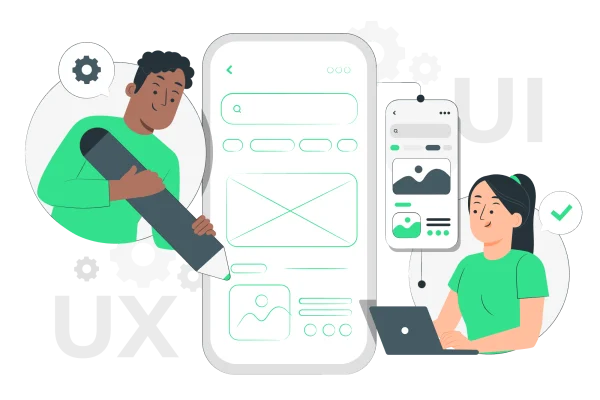What is UIUX Design?
Imagine yourself smoothly scrolling through your preferred app by tapping and swiping. UI and UX designers perform their magic to create that smooth experience. User Interface, or UI, is all about how an application or website looks and feels—the buttons, colors, and general design elements that contribute to its visual appeal.

Let us introduce you to User Experience or UX. This is the mastermind behind the scenes who makes sure your experience using the app is seamless and fulfilling. UX designers plan every step of the user’s journey, from the first app launch to the last task fulfillment. Like building an online theme park, it’s enjoyable, simple to use, and gives you a sense of satisfaction.
In summary, UX is the mastermind behind creating an arrangement of interactions that pull you in, whereas UI is the design, the images that grab your attention. They are the dynamic pair reshaping our interactions with the digital world together.
State of UI/UX Design Right Now
The present state of UI/UX design is exciting and demanding as we ride the digital wave. Not only do designers create images, but they also build experiences by balancing functionality and aesthetics.

Design Harmony
Design is more than simply a lovely face in the modern digital world. It all comes down to crafting a seamless, immersive experience. UI elements emphasize simplicity and clarity and are clean, minimalist, and frequently inspired by the ideas of flat design. The way that font, color, and spacing interact is carefully planned to give users an aesthetically pleasant experience.
Responsive Design
Designers must create interfaces that adapt seamlessly to the variety of devices we use, including smartphones, tablets, and desktop computers. The usage of responsive design has become standard practice, guaranteeing a consistent and pleasurable user experience on a range of screen sizes.
Micro-interactions
You know that little animation you see when you ‘like’ a post or tap through your feed? Digital experiences are given liveliness by these micro-interactions. Right now, it’s all about these tiny but powerful animations that boost user engagement and foster a fun relationship between the user and the UI.
User-Centric Approach
Designers understand that the user is important. User research and feedback are more important now than ever. The compass that directs design decisions is an understanding of user behavior, preferences, and pain areas. Prototyping and user testing are now essential stages in the design process that guarantee the final product will appeal to the target market.
Accessibility Is Important
Being inclusive is key. Accessible interface design is becoming increasingly important for designers working with a wide range of user abilities. This expands the market for digital products while concurrently sticking to ethical design guidelines.
Data-Driven Design
UI/UX design is not free from the big data era. Analytics and user data are having a greater and bigger impact on design decisions. Heatmaps and A/B testing enable designers to optimize and continuously enhance user interfaces by fine-tuning them based on actual user interactions.
Future of UI/UX Design
UI/UX design is the compass, guiding us through a world of changing technology and user expectations in which digital experiences impact our interactions. Let’s examine 6 fascinating trends that will shape the direction of UI/UX design in the upcoming years as we enter this fascinating field.

Immersive Experiences
UI/UX design is going to explore immersive domains in the future. Think beyond the screen. Virtual reality (VR) and augmented reality (AR) are more than simply idioms; they are defining the future frontier. Designers will be putting together multimodal experiences that engage people beyond just looks.
Voice and Gesture Interfaces
Hyper-Personalization
Ethical and Inclusive Design
Evolution of Haptic Feedback
Haptic feedback is about to go beyond ordinary vibrations and into a new phase. With the use of sophisticated haptic technology, designers will be able to produce subtle feelings that will provide consumers with a tactile experience in addition to visual and aural ones.
Biometric Integration
UI/UX designers will skillfully incorporate fingerprint scans, facial recognition, and other biometric data into interfaces as biometric authentication gains traction. This simplifies the user authentication procedure while simultaneously enhancing security.
Interactive Data Visualization
With interactive data visualization, applications with a lot of data will change. Through user-friendly and visually appealing interfaces, users will be able to study and engage with complicated datasets, increasing the accessibility and understandability of information.
Dynamic Content Adaptation
User preferences, context, and real-time data will all play a role in how interfaces adapt and customize content. AI will be used by designers to develop interfaces that can learn from user interactions and provide a customized and relevant user experience.
Immersive Typography
With this technique, text appears on a screen as more than just words. It will be crucial to use dynamic and immersive typography to guide user journeys, evoke strong feelings, and produce lasting impressions. The possibilities are endless, ranging from interactive fonts to animated text.
Ethical and Inclusive Design
UI/UX designers will skillfully incorporate fingerprint scans, facial recognition, and other biometric data into interfaces as biometric authentication gains traction. This simplifies the user authentication procedure while simultaneously enhancing security. With interactive data visualization, applications with a lot of data will change. Through user-friendly and visually appealing interfaces, users will be able to study and engage with complicated datasets, increasing the accessibility and understandability of information. User preferences, context, and real-time data will all play a role in how interfaces adapt and customize content. AI will be used by designers to develop interfaces that can learn from user interactions and provide a customized and relevant user experience. With this technique, text appears on a screen as more than just words. It will be crucial to use dynamic and immersive typography to guide user journeys, evoke strong feelings, and produce lasting impressions. The possibilities are endless, ranging from interactive fonts to animated text.
Ethical and Inclusive Design
UI/UX designers will skillfully incorporate fingerprint scans, facial recognition, and other biometric data into interfaces as biometric authentication gains traction. This simplifies the user authentication procedure while simultaneously enhancing security. With interactive data visualization, applications with a lot of data will change. Through user-friendly and visually appealing interfaces, users will be able to study and engage with complicated datasets, increasing the accessibility and understandability of information. User preferences, context, and real-time data will all play a role in how interfaces adapt and customize content. AI will be used by designers to develop interfaces that can learn from user interactions and provide a customized and relevant user experience. With this technique, text appears on a screen as more than just words. It will be crucial to use dynamic and immersive typography to guide user journeys, evoke strong feelings, and produce lasting impressions. The possibilities are endless, ranging from interactive fonts to animated text.
Intelligent Microinteractions
Context-aware and intelligent micro-interactions will emerge. These tiny interactions will react intelligently to user behavior in place of generic animations, giving feedback that feels customized and improves the user experience overall.
Evolution of Haptic Feedback
Haptic feedback is about to go beyond ordinary vibrations and into a new phase. With the use of sophisticated haptic technology, designers will be able to produce subtle feelings that will provide consumers with a tactile experience in addition to visual and aural ones.
Biometric Integration
Interactive Data Visualization
Dynamic Content Adaptation
Immersive Typography
Intelligent Microinteractions
Context-aware and intelligent micro-interactions will emerge. These tiny interactions will react intelligently to user behavior in place of generic animations, giving feedback that feels customized and improves the user experience overall.
Evolution of Haptic Feedback
Haptic feedback is about to go beyond ordinary vibrations and into a new phase. With the use of sophisticated haptic technology, designers will be able to produce subtle feelings that will provide consumers with a tactile experience in addition to visual and aural ones.
Biometric Integration
Interactive Data Visualization
Dynamic Content Adaptation
Immersive Typography
Intelligent Microinteractions
Context-aware and intelligent micro-interactions will emerge. These tiny interactions will react intelligently to user behavior in place of generic animations, giving feedback that feels customized and improves the user experience overall.


